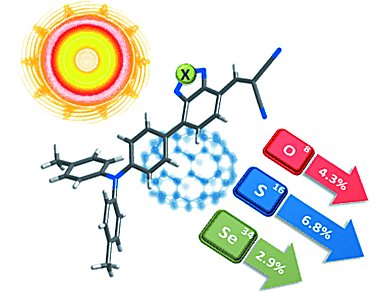The low weight, mechanical flexibility, and low cost of organic solar cells (OSCs), together with their environmentally benign manufacturing process, make them more attractive than the market-dominant Si-based solar cells.
Hao-Wu Lin, National Tsing Hua University, Hsin Chu, Taiwan, and colleagues have synthesized four new molecules with a donor–acceptor–acceptor (D-A-A) configuration as electron donors for small-molecule organic solar cells (SMOSCs). In these molecules 2,1,3-benzoxadiazole (BO) or 2,1,3-benzoselenodiazole (BS) are adopted as the central bridging acceptor. The molecules are:
- 2-[(7-{4-[N,N-bis(4-methylphenyl)amino]phenyl}-2,1,3-benzoxadiazol-4-yl)methylene]propanedinitrile (DTDCPBO);
- 2-[(7-{4-[N,N-bis(4-methylphenyl)amino]thiophenyl}-2,1,3-benzoxadiazol-4-yl)methylene]propanedinitrile (DTDCTBO);
- 2-[(7-{4-[N,N-bis(4-methylphenyl)amino]phenyl}-2,1,3-benzoselenodiazol-4-yl)methylene]propanedinitrile (DTDCPBS);
- 2-[(7-{4-[N,N-bis(4-methylphenyl)amino]thiophenyl}-2,1,3-benzoselenodiazol-4-yl)methylene]propanedinitrile (DTDCTBS).
In conjunction with two previously reported 2,1,3-benzothiadiazole-based compounds, it was observed that the dihedral angle between the benzochalcogenodiazole and phenylene or thiophene unit increased, the oxidation and reduction potentials were negatively shifted, and that the molar extinction coefficient of the absorption maximum decreased. The BO- and BS-based molecules showed a redshifted absorption maximum compared to their BT-based counterparts because of the larger electronegativity of the O atom and the longer Se–N bond that causes a decrease in aromaticity.
Vacuum-deposited hybrid planar mixed-heterojunction devices build with these donors and C70 as the acceptor, show power conversion efficiencies in the range of 2.9–4.3 % under 1 sun (100 mWcm–2) AM 1.5 G simulated solar illumination.
The results show that subtle structural differences lead to quite different physical properties and using a material that has the preferred optoelectronic characteristics required for efficient donor materials does not necessarily ensure a good device performance.
- Benzochalcogenodiazole-Based Donor–Acceptor–Acceptor Molecular Donors for Organic Solar Cells,
Hao-Chun Ting, Yi-Hong Chen, Li-Yen Lin, Shu-Hua Chou, Yi-Hung Liu, Hao-Wu Lin, Ken-Tsung Wong,
ChemSusChem 2014.
DOI: 10.1002/cssc.201301090



